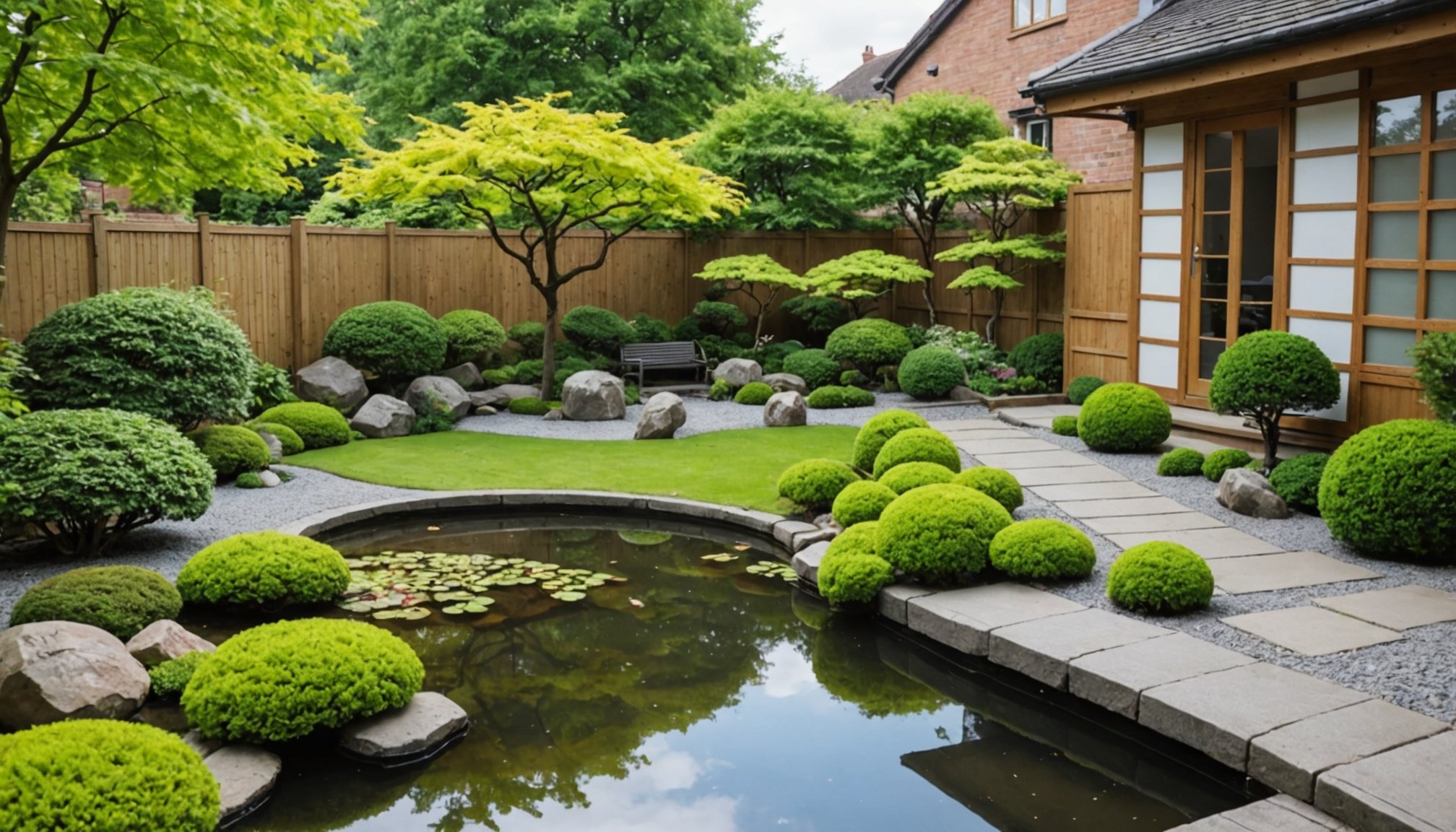A serene Japanese garden can transform your UK townhouse backyard into a peaceful retreat. Imagine lush greenery, carefully arranged stones, and the gentle sound of water. This style fosters relaxation and mindfulness, making it perfect for busy urban living. Embrace the art of creating a tranquil space that not only enhances your home’s aesthetic but also provides a sanctuary from daily stresses. Discover practical tips and inspirations to achieve this harmonious oasis right in your own backyard.
Inspiration for a Japanese Garden Design
Creating a serene outdoor space in a UK townhouse garden can be achieved by embracing the principles of Japanese garden design. This style is renowned for its emphasis on tranquility, harmony, and balance, which makes it ideal for small spaces.
Dans le meme genre : Transform Your UK Study Room: Creative Ways to Incorporate Vintage Maps as Wall Art
Japanese gardens come in various styles, each offering unique characteristics. Zen gardens, for example, are minimalist and often feature raked gravel or sand, symbolizing water ripples, alongside simple rock arrangements. These elements are designed to promote meditation and introspection. In contrast, tea gardens incorporate stepping stones, lanterns, and water basins, creating a peaceful path leading to a traditional tea house. Stroll gardens are more expansive, designed for walking and contemplation, with winding paths and carefully placed plants and water features.
When designing a Japanese garden in a limited space, consider the following key design principles:
En parallèle : Selecting the Perfect Shade of Grey to Elevate Your UK Living Space’s Sophistication
- Simplicity: Use a restrained palette of plants and materials.
- Balance: Arrange elements in a way that feels natural and harmonious.
- Symbolism: Incorporate symbolic elements such as rocks, water, and plants to represent natural landscapes.
Visual examples of Japanese gardens in small spaces often showcase how these principles can transform a typical UK townhouse garden into a tranquil retreat. By focusing on these core elements, you can create a peaceful and inviting outdoor sanctuary.
Selecting the Right Plants for Your Garden
Choosing the appropriate Japanese plants for your garden is crucial to achieving an authentic and harmonious design. The selection should align with the principles of Japanese garden aesthetics while also considering the UK climate.
Essential Japanese Plants for UK Gardens
Incorporating traditional Japanese plants can enhance the garden's authenticity. Maples, with their vibrant foliage, are a popular choice, providing striking seasonal colour. Bamboo serves as an excellent screening plant, adding vertical interest and a sense of enclosure. Azaleas and rhododendrons offer bursts of colour, while moss can be used to create lush, green carpets, contributing to a serene atmosphere.
Seasonal Planting Considerations
When planning your garden, it's essential to consider the seasonal changes and how they affect your plants. Japanese gardens often highlight the beauty of the seasons, with cherry blossoms in spring and the vivid hues of maples in autumn. Selecting plants that thrive in the UK climate ensures year-round interest and reduces maintenance.
Native species should be considered for climate adaptation, ensuring the garden thrives without extensive intervention. By combining Japanese plants with those native to the UK, you can create a garden that's both beautiful and sustainable, reflecting the natural beauty of both landscapes.
Incorporating Traditional Japanese Elements
To create an authentic Japanese garden, integrating cultural elements is essential. Water features, such as ponds, streams, and waterfalls, play a significant role in these serene landscapes. They symbolize the flow of life and add a soothing auditory dimension. When designing a pond, consider adding koi fish to enhance the garden's vibrancy.
Stone pathways and lanterns are iconic Japanese garden elements that guide visitors through the space. Pathways, often made from natural stone, connect different sections of the garden, encouraging a contemplative journey. Lanterns, traditionally crafted from stone, serve both as functional lighting and decorative accents, adding an element of timeless beauty.
Incorporating bonsai and other traditional plant forms can further enhance the garden's authenticity. Bonsai trees, with their miniature size and meticulous pruning, embody the Japanese art of patience and precision. Alongside bonsai, consider using carefully shaped pines and azaleas to create a harmonious blend of textures and colours.
These Japanese garden elements not only contribute to the aesthetic appeal but also reflect the cultural philosophy of harmony with nature. By thoughtfully integrating these features, you can transform your garden into a tranquil sanctuary that honours traditional Japanese design principles.
Step-by-Step Guide to Planning Your Garden
Embarking on a garden planning journey involves meticulous attention to detail and a clear vision. Begin by selecting the ideal space in your backyard. Consider areas that receive optimal sunlight and have good drainage. This initial step is crucial, as the right location sets the foundation for a thriving garden.
Once you've chosen your space, focus on preparing the soil and site for planting. Start by clearing the area of debris and weeds. It's essential to test the soil's pH and nutrient levels, adjusting them to suit the plants you intend to grow. Enriching the soil with organic matter, such as compost, enhances its fertility and structure, creating a nurturing environment for your plants.
Timing is another critical aspect of the step-by-step guide. The best seasons for planting and construction vary depending on your climate and the plants you choose. Generally, spring and autumn are ideal, as they offer moderate temperatures and moisture levels, promoting healthy growth.
By following these landscaping tips and carefully planning each step, you can transform your backyard into a serene and harmonious retreat, reflecting the essence of Japanese garden design.
Maintenance Tips for a Thriving Japanese Garden
Ensuring your Japanese garden remains vibrant and healthy requires consistent attention and care. Here, we explore essential garden maintenance practices that will help your garden flourish.
Regular Maintenance Routines
Routine garden maintenance is crucial. Start by scheduling regular pruning sessions to maintain the desired shape and size of your plants, particularly for bonsai and maples. This not only supports plant health but also enhances the aesthetic appeal. Keep pathways clear by regularly sweeping leaves and debris, ensuring the garden remains inviting. Water features should be checked frequently to ensure they are functioning correctly and free from algae buildup. Regular cleaning prevents stagnation and maintains water clarity.
Seasonal Care Adjustments
Seasonal care is vital to adapt to changing weather conditions. In spring, focus on fertilising plants to boost growth, while summer may require increased watering due to higher temperatures. Autumn is an ideal time for mulching, which helps retain soil moisture and insulates roots during winter. Winter care involves protecting sensitive plants from frost with coverings or relocating them indoors.
Managing pests and diseases is integral to plant care. Use organic solutions like neem oil to deter pests, and regularly inspect plants for signs of disease. Early detection and treatment are key to preventing widespread issues and ensuring your garden's longevity.
Adapting Japanese Garden Concepts for Smaller Spaces
Incorporating Japanese garden aesthetics into a small garden design can transform even the tiniest urban gardening spaces into serene retreats. By employing space-saving techniques, you can create a harmonious environment that reflects the tranquility of traditional Japanese gardens.
Vertical Gardening Techniques
Vertical gardening is an effective approach for limited spaces. By using trellises or vertical planters, you can cultivate climbing plants like wisteria or ivy, which add lush greenery without occupying ground space. This method not only maximizes your planting area but also creates a layered visual effect, enhancing the garden's depth.
Containers and Raised Beds
Utilising containers and raised beds is another practical solution for urban gardening. These allow you to grow a variety of plants, from maples to azaleas, in confined areas. Raised beds can be strategically placed to define pathways or create focal points, adding structure to the garden layout.
Creative Solutions for Seating and Decor
Incorporating seating and decor in a compact area requires creativity. Consider foldable or multi-functional furniture that can be easily moved or stored. Decorative elements like stone lanterns or small water features can be integrated without overwhelming the space, maintaining the garden's peaceful ambiance.











